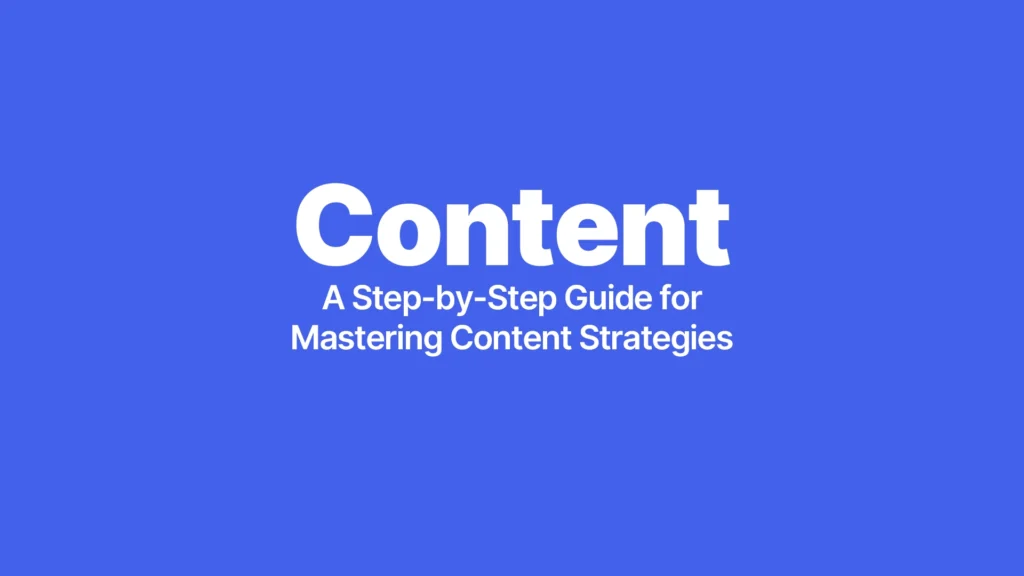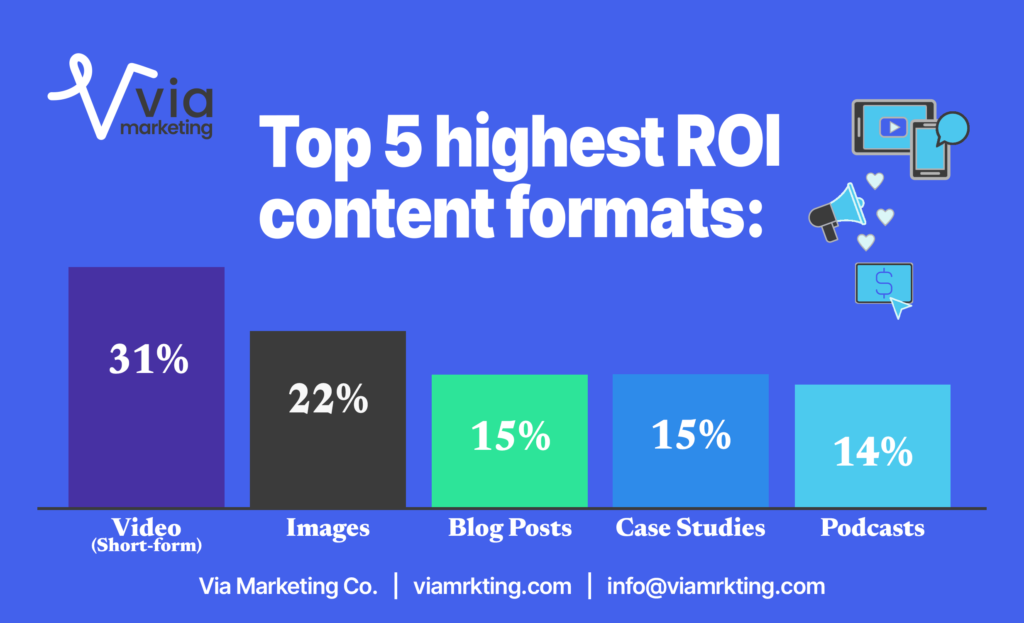Want to create successful content strategies for 2025? This guide will teach you how to plan, create, and manage content that meets your business goals and engages your audience. Discover the essential steps for developing a winning content strategy.
Key Takeaways
- A well-defined content strategy aligns business goals with audience needs, guiding content planning, creation, and distribution to enhance customer engagement and organic traffic.
- Content strategy focuses on the ‘why’ and ‘how’ of content creation, providing a framework, whereas content marketing deals with the ‘what’ and ‘where’, executing the planned strategy to achieve marketing goals.
- Core elements of a successful content strategy include setting SMART goals, defining the target audience with detailed personas, developing a content calendar, and using analytics tools to measure and optimize performance.
Understanding Content Strategies

A content strategy acts as a guide to realize your business goals via content marketing. It involves:
- Planning
- Creating
- Publishing
- Managing
- Governing content that engages and provides value at each stage of the buyer’s journey.
Fundamentally, it involves aligning your business objectives with your audience’s needs so each content piece mirrors your brand’s identity and connects with both potential and current customers.
Imagine driving without a GPS. A content strategy:
- Outlines the fastest and most efficient route to your desired destination
- Helps you to respond to changing market conditions
- Helps you interpret data effectively to decide the next steps
- Allows brands to create compelling narratives and rich content experiences that inform, engage, and inspire
Success in creating a content strategy is achievable for anyone, provided they understand their audience, establish clear goals, and consistently deliver high-quality content in line with their marketing efforts.
When done right, a content strategy not only improves customer engagement but also builds lasting relationships and drives organic traffic to your business.
Content Strategy vs. Content Marketing: Key Differences
Despite the frequent interchangeability of the terms content strategy and content marketing, they fulfill unique roles. Content strategy encompasses the planning, development, and management of content, laying down the framework for the content creation process. It focuses on the ‘why’ and ‘how’ of content creation, ensuring that every piece of content aligns with your business goals and audience needs.
On the other hand, content marketing is about the execution of the planned content to engage audiences and achieve specific marketing goals. It deals with the ‘what’ and ‘where’—what content to produce and where to distribute it. A solid content strategy is essential to guide your content marketing efforts effectively, ensuring that your marketing tactics are grounded in a well-thought-out plan.
Why Your Business Needs a Content Strategy
For any business aspiring to prosper in the current digital scenario, a well-defined content strategy is imperative. It provides a roadmap for creating valuable content at each stage of the buyer’s journey, which in turn improves customer engagement. This engagement helps build a relationship with your target audience, establishing your business as an expert in your field.
A content strategy goes beyond mere content production; it involves creating content that consistently leads to conversions. By providing clear guidelines on the target audience, tone, style, and distribution channels, a documented strategy ensures that all marketing efforts are goal-driven and effective. This leads to increased organic traffic and better overall performance of your content marketing efforts.
Moreover, a good content strategy helps:
- Identify new content creation opportunities by outlining avenues to follow news and trends
- Businesses with a documented content strategy are significantly more effective at content marketing compared to those without one
- Enhance customer engagement, build relationships, and drive organic traffic
So, if you’re looking to enhance customer engagement, build relationships, and drive organic traffic, a content strategy is indispensable.
Core Components of an Effective Content Strategy

The success of a content strategy hinges on its core components:
- Establishing transparent business goals
- Identifying the target audience
- Devising a content calendar
- Crafting high-quality content
Each of these elements plays a crucial role in ensuring that your content marketing efforts are aligned with your overall business objectives.
From setting SMART goals to conducting audience research and creating a detailed content calendar, these components help in organizing and streamlining your content production and distribution efforts. By focusing on these key elements, you can develop a content strategy framework that not only meets your marketing goals but also resonates with your audience.
Setting Clear Business Goals
The establishment of transparent business goals forms the linchpin of a triumphant content strategy. By aligning your content goals with overall business objectives, you create a roadmap that guides all your marketing efforts. Using the SMART framework—Specific, Measurable, Achievable, Relevant, and Time-bound—ensures that your goals are well-defined and attainable.
Conducting a content audit is also an essential step in this process. By reviewing your existing content, you can assess its performance and relevance to your company’s goals, allowing you to refine your strategy and focus on what truly matters. Additionally, considering budget and human resources ensures that your content strategy is not only ambitious but also practical and executable.
Defining Your Target Audience
Defining your target audience is crucial for creating content that resonates and engages. This involves developing detailed buyer personas—fictional representations of your ideal customers that detail their demographics, goals, and challenges. Buyer personas help in planning content that addresses the specific needs and aspirations of your audience, making your content marketing efforts more effective.
Creating these personas involves asking questions about your audience’s:
- demographics
- psychographics
- interests
- values
- needs
This data-driven approach ensures that your content reflects the true preferences and pain points of your potential customers. By refining these personas as more customer data and feedback are gathered, you can keep your content strategy aligned with evolving market trends.
Via Marketing, for instance, uses buyer personas to transform content marketing strategies, creating multiple personas if a business caters to different customer segments. This tailored approach ensures that the content resonates deeply with each target audience, driving better engagement and conversions.
Developing a Content Calendar
To ensure consistency and adherence to deadlines in the content creation process, a content calendar is a necessary tool. It helps in organizing your content efforts, ensuring that you stay on track and produce content in a timely manner. By planning and scheduling content in advance, you can maintain a steady flow of high-quality content that keeps your audience engaged.
Using tools like Trello, Asana, or Google Sheets can facilitate the creation of effective editorial calendars, allowing you to plan content topics, assign tasks, and set deadlines. This structured approach not only improves efficiency but also ensures that your content strategy is executed seamlessly.
Step-by-Step Guide to Creating a Content Strategy
The process of developing a content strategy comprises several significant steps:
- Performing audience research
- Scrutinizing competitors
- Establishing quantifiable objectives
- Developing your brand voice
Each of these steps is crucial in developing a content strategy that is both effective and aligned with your business goals.
By following this step-by-step guide, you can ensure that your content strategy is comprehensive and well-rounded, addressing all aspects of content marketing from research and planning to execution and optimization.
Conducting Audience Research

Understanding your target audience is the first step in creating a successful content strategy. Conducting thorough audience research helps in creating more authentic and useful content by understanding the audience’s needs and pain points. This involves creating detailed buyer personas based on data and research, which guide your content creation process.
Methods for gathering insights include conducting surveys and interviews, analyzing social media analytics, and tracking user behavior metrics. These insights help in tailoring your content strategy to reflect the true preferences and interests of your audience, ensuring that your content resonates and engages effectively.
Analyzing Competitors
Analyzing competitors is a crucial step in developing a content strategy. By conducting market and competitive research, you can gain insights into audience preferences and competitor tactics, identifying gaps and opportunities for differentiation. This involves examining the content practices of businesses targeting similar audiences, including the type of content they publish and how their audience engages with it.
Tools like SEMrush and Ahrefs are invaluable for tracking keyword performance and SEO metrics, helping you understand what works and what doesn’t in your industry. This competitive research not only reveals industry standards but also provides opportunities to create unique content that fills market gaps.
Setting Measurable Objectives
Setting measurable objectives is essential for a goal-driven content strategy. Using the SMART framework—Specific, Measurable, Achievable, Relevant, and Time-bound—ensures that your content marketing objectives are well-defined and attainable. This structured approach helps in steering your tactics toward the end goals, ensuring that all efforts are focused and effective.
Examples of SMART goals include generating 50% more qualified leads in 90 days or doubling social media followers in 60 days. By setting such clear and measurable objectives, you can track your progress and make necessary adjustments to stay on course.
Crafting Your Brand Voice
A consistent brand voice is vital for conveying your brand values and identity effectively. Establishing a brand voice that aligns with the needs and values of your target audience helps in creating content that resonates deeply. This involves defining style, tone, and messaging guidelines that ensure consistency across all content.
Brand guidelines help maintain this consistency, specifying how your brand should communicate in different contexts. By crafting a clear and distinct brand voice, you can build stronger connections with your audience and enhance customer engagement.
Implementing Your Content Plan
The execution phase is where your content plan comes to fruition. This involves:
- The content creation process
- Choosing the right content formats
- Selecting distribution channels to ensure that your content reaches the intended audience
A well-executed content marketing strategy improves a brand’s visibility on search engines and enhances customer engagement.
By setting standards and policies for content creation, publication, and maintenance, you can ensure consistent delivery of high-quality content that aligns with your marketing strategy.
Content Creation Process
A structured content creation process is essential for ensuring efficiency and high-quality output when you create content. This process typically includes steps from idea generation to publication, involving collaborative tools and structured workflows that enhance productivity. Tools like Grammarly for advanced grammar and style checking, and Wordable for seamless publishing of Google Docs content directly to WordPress, can significantly streamline this process.
SEO best practices should also be integrated into the content creation process, such as using relevant keywords in meta titles and descriptions. By implementing content governance policies, you can maintain standards and consistency, ensuring that every piece of content meets your quality benchmarks and aligns with your brand voice.
Choosing the Right Content Formats

Choosing the right content formats is crucial for maximizing engagement and effectiveness. Understanding your content goals—whether it’s brand awareness, lead generation, customer engagement, sales, or SEO—helps in selecting the appropriate formats. For instance, short-form videos and images have the highest ROI and are ideal for quick, engaging content, while blog posts and case studies are great for providing valuable information and building trust.
Evaluating the ROI of different content formats can guide your choices effectively:
- Short-form video with (31%)
- Images (22%)
- Blog posts (15%)
- Case studies (15%)
- Podcasts (14%)
These statistics highlight which formats tend to yield the best returns, allowing you to allocate resources more efficiently and focus on the most impactful types of content.
Audience preferences and platform compatibility also play a significant role in this decision. Ensuring that the chosen formats work well on the target platforms and align with your team’s skills, budget, and time constraints is essential. Experimenting with different formats and analyzing their performance can help refine your strategy and optimize content impact.
Distribution Channels
Selecting the right distribution channels is key to ensuring your content reaches the intended audience. Social media platforms, email marketing, and websites are primary channels for content distribution, each offering unique advantages for customer engagement and feedback. A comprehensive content distribution strategy should leverage various media types, including earned, paid, and owned channels, to maximize reach and impact.
Understanding your audience’s preferred social media channels, devices used, and content format preferences helps in tailoring your distribution efforts. Repurposing content across different platforms can also enhance visibility and reach, ensuring that your marketing efforts are efficient and effective.
Measuring and Optimizing Content Performance

To evaluate the efficacy of your content strategy, it is imperative to measure and optimize content performance. Tracking relevant metrics and KPIs helps identify which strategies are working and which need improvement. Metrics like website traffic, engagement rates, and conversion rates provide insights into how well your content aligns with business goals and resonates with your audience.
Regularly analyzing these metrics allows you to:
- Make data-driven decisions
- Optimize your content strategy for better results
- Continuously track performance
- Make precise adjustments
- Enhance content impact and ROI.
Key Performance Indicators (KPIs)
Establishing key performance indicators (KPIs) is essential for evaluating the success of your content strategy. Metrics like views, new users, and website traffic help gauge content reach and interest. Engagement rates, such as likes, shares, and comments, reflect audience interaction with your content, while bounce rates measure the percentage of unengaged sessions.
Conversion rates are a critical KPI for assessing how content drives sales and leads. Monitoring these metrics helps identify areas for improvement and ensures that your content strategy is aligned with your business goals.
Using Analytics Tools
Analytics tools are indispensable for gaining insights into content performance and making data-driven decisions. Google Analytics and social media analytics tools provide valuable data on traffic sources, engagement, and reach, helping you understand which channels and content types are most effective. Google Analytics 4 (GA4), in particular, can track page views and analyze traffic sources, offering a detailed view of content performance.
By leveraging these tools, businesses can continuously optimize their content strategies, tailor their content to audience preferences, and improve overall engagement and reach. This iterative process ensures that your content marketing efforts remain effective and aligned with your goals.
Iterating Based on Feedback
Continuous iteration based on feedback is vital for maintaining a successful content strategy. Here are some key steps to follow:
- Gather audience feedback to understand which content topics resonate most and which do not.
- Use this feedback to refine your content strategy accordingly.
- Regularly review performance data to make informed adjustments that better meet audience needs and preferences.
By following these steps, you can ensure that your content strategy remains effective and aligned with your audience’s interests.
Experimenting with different formats and channels is also crucial for determining the most effective content types. By staying vigilant and adapting to the evolving market and customer needs, you can ensure that your content strategy remains relevant and impactful.
Leveraging Specialized Content Tools
Utilizing specialized content tools can substantially augment your content strategy. Tools like AI writing assistants and content management systems (CMS) streamline the content creation process, ensuring efficiency and consistency.
These tools provide insights and functionalities that help in creating high-quality content, such as a blog post, and managing it effectively across various platforms.
AI Writing Assistants
AI writing assistants are designed to automate and streamline the content creation process, saving significant time and ensuring consistency in voice and tone. Tools like Semrush’s AI Writing Assistant, Jasper, and Copy.ai are popular examples that help generate SEO content, marketing copy, and engaging social media posts.
Content Management Systems (CMS)
Content management systems (CMS), also known as content management system, are crucial for managing digital content efficiently. These platforms offer user-friendly editors, media management tools, and the ability to extend functionality through plugins and themes. Using a CMS can improve workflow efficiencies, facilitate collaboration, and ensure more consistent content publishing, ultimately driving better audience engagement and higher website traffic.
Summary
In conclusion, a well-crafted content strategy is essential for achieving business goals and engaging your target audience effectively. By understanding the differences between content strategy and content marketing, setting clear business goals, defining your target audience, developing a content calendar, and leveraging specialized tools, you can create a successful content marketing strategy that drives results. Implement these insights and watch your content efforts transform into powerful marketing assets.
Frequently Asked Questions
What is the difference between content strategy and content marketing?
The main difference between content strategy and content marketing is that content strategy focuses on planning and management, while content marketing emphasizes the execution and distribution to engage audiences and accomplish marketing objectives. Understanding this difference can help you effectively leverage both approaches to enhance your content efforts.
Why is a content strategy important for my business?
A content strategy is important for your business because it improves customer engagement, builds relationships, and drives organic traffic, ultimately leading to business growth and success.
How do I define my target audience?
To define your target audience, create detailed buyer personas based on data and research, allowing you to plan content that meets their specific needs and aspirations. This will help you tailor your messaging effectively and connect with your audience in a meaningful way.
What tools can help in creating and managing content?
You can use AI writing assistants and Content Management Systems (CMS) to streamline content creation and efficiently manage digital content. These tools can help make the content creation process easier and more organized.
How do I measure and optimize content performance?
To measure and optimize content performance, track metrics such as website traffic, engagement rates, and conversion rates using tools like Google Analytics. Review performance data regularly and make adjustments based on feedback to optimize your content strategy.